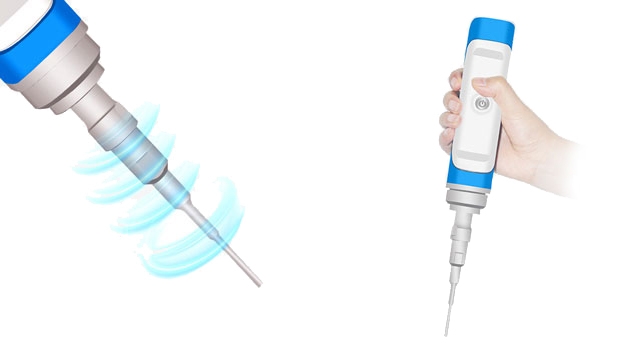Ultrasonic homogenizer is a highly efficient tool widely used in laboratories and industries. Ultrasonic homogenizer plays a key role in the field of sample processing and dispersion with its unique ultrasonic technology. This technology is based on the principle of acoustic vibration, which transmits high-frequency ultrasonic energy into the liquid, generating strong shear force and pressure fluctuation, thus making the sample dispersed uniformly, the particle size reduced, the solubility increased, and the reaction speed accelerated, which effectively improves the efficiency and quality of the experimental and production process.
Main Functions
- Dispersing and Homogenizing Samples: The ultrasonic homogenizer can evenly disperse particles, solid substances, or liquid molecules in the sample in the solvent. This is important for the preparation of homogeneous samples or suspensions, such as particle analysis, nanomaterial preparation, etc.
- Cell Breaking: Ultrasonic homogenizers can be used to break down cell walls and release biomolecules within the cell, such as proteins, DNA, RNA, etc. This is very useful in molecular biology and cell biology research.
- Dissolving Difficult Substances: Ultrasound can create localized hot spots of high energy in the sample, which helps to dissolve some difficult substances, such as solid catalysts in chemical reactions.
- Reaction Facilitation: Ultrasound in an ultrasonic homogenizer can accelerate chemical reactions, reduce reaction temperature and time, and improve reaction efficiency.
Usage Scenarios
Sample Crushing and Homogenization: Ultrasonic homogenizers are mainly used to disperse or crush cells, organelles, or biomolecules in samples. Ultrasonic homogenizers are very common in biotechnology and molecular biology experiments, such as the extraction and purification of DNA, RNA, or proteins. Ultrasonic homogenizers can help ensure that the biomolecules in a sample are evenly mixed for accurate experimental results.
Cell Breaking: In cell biology research, ultrasonic homogenizers are used to break down cell membranes and release intracellular material. Ultrasonic homogenizers are important for extracting DNA, RNA, or proteins from cells for subsequent analysis and research.
Sample Pre-treatment: Before analysis, it is sometimes necessary to pre-treat samples, such as breaking tissue samples into cell suspensions for analysis or testing. Ultrasonic homogenizers can perform this task efficiently.

Nanoparticle Dispersion: In the field of materials science and nanotechnology, ultrasonic homogenizers are used to disperse nanoparticles to ensure that they are evenly distributed in solution. Ultrasonic homogenizer is important for the preparation of nanomaterials and nanoparticle research.
Size Analysis: Ultrasonic homogenizers are also used for particle size analysis to help determine the size distribution of particles in a sample. The ultrasonic homogenizer is useful in particle studies, analysis of liquid suspensions, and quality control of particles.
Efficient Sample Processing: In the laboratory, sometimes a large number of samples need to be processed. The ultrasonic homogenizers provide efficient and consistent sample processing that is more reliable than manual processing, making them especially important in high-through put experiments.
Biopharmaceutical: In the pharmaceutical industry, ultrasonic homogenizers are used to prepare vaccines, protein drugs, and other biologics. Ultrasonic homogenizers ensure consistency and quality control during production.
Chemical Synthesis: In chemical synthesis, ultrasonic homogenizer is sometimes necessary to uniformly disperse or suspend solid particles in a chemical reaction. Ultrasonic homogenizers can be used for these purposes to ensure a successful reaction.
Sample Preparation: In analytical chemistry and environmental sciences, sample preparation often involves dispersing solid samples into liquids for subsequent analyses such as chromatography or mass spectrometry.
Biofuel Research: In biofuel research, ultrasonic homogenizers are used to break up and homogenize biomass to extract substances that can be used to produce biofuels.
Precautions
- Safety: The ultrasonic waves in an ultrasonic homogenizer are high energy fluctuations that must be kept safe for the operator. Wear appropriate personal protective equipment, such as goggles and gloves, and follow the equipment's safety instructions.
- Sample Selection: Not all samples are suitable for processing in an ultrasonic homogenizer. Some samples may be adversely affected by the ultrasonic waves in the ultrasonic homogenizer, so the characteristics of the sample should be carefully considered before use.
- Power and Time Control: The power and time settings of the ultrasonic homogenizer should be adjusted to the specific sample and application to avoid over or under-treatment.
- Cleaning and Maintenance: Regular cleaning and maintenance of the ultrasonic homogenizer to ensure stable performance and long life of the ultrasonic homogenizer. sisco online shop has professional engineers and technicians, we can provide professional technical support and consulting services if you encounter any doubts or problems when using an ultrasonic homogenizer, and high-quality ultrasonic homogenizers are available for selection. If you are interested, welcome to visit us.
Ultrasonic homogenizers are used in a wide range of applications in biotechnology, biochemistry, chemical synthesis, and materials science. Ultrasonic homogenizers can process samples efficiently and homogeneously to ensure the accuracy and reproducibility of experiments and therefore are a very useful experimental tool when samples need to be broken, homogenized, or dispersed.

